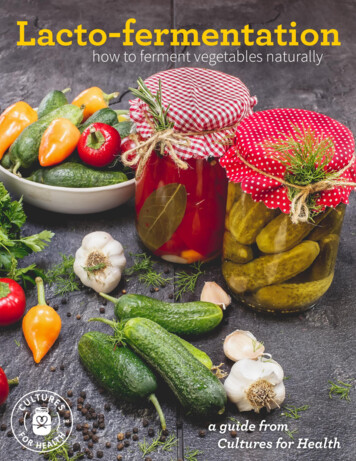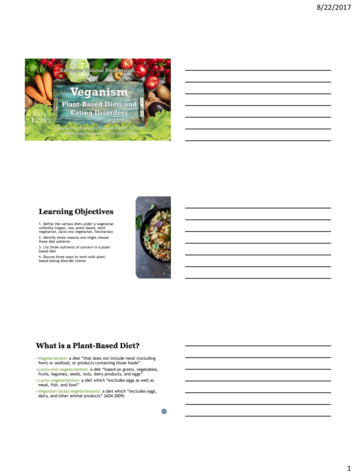
Transcription
LACTO-FERMENTATION from Cultures for Healtha guide by Cultures for Health 2016 Cultures for Health2 Page
LACTO-FERMENTATION from Cultures for HealthDisclaimerThe ideas, concepts, and opinions expressed in this book are intended to be used for educationalpurposes only. This book is provided with the understanding that authors and publisher are notrendering medical advice of any kind, nor is this book intended to replace medical advice, nor todiagnose, prescribe, or treat any disease, condition, illness, or injury.It is imperative to use good judgment when consuming fermented food and to never consume anyfermented food that looks, tastes, or smells unpleasant. Further, before consuming lacto-fermentedor any other fermented or cultured food, you should receive full medical clearance from a licensedphysician. Author and publisher claim no responsibility to any person or entity for any liability, loss, ordamage caused or alleged to be caused directly or indirectly as a result of the use, application, orinterpretation of the material in this book.CopyrightCopyright 2016 by Cultures for Health. All rights reserved.Except as permitted under the United States Copyright Act of 1976, reproduction or utilization of thiswork in any form or by any electronic, mechanical, or other means, now known or hereafter invented,including xerography, photocopying, and recording, and in any information storage and retrievalsystem, is forbidden without written permission of Cultures for Health.Publisher:Cultures for Health200 Innovation Avenue Suite 150Raleigh, NC 27560800-962-1959919-695-9600 (fax)www.culturesforhealth.comFor more information on lacto-fermentation or other cultured and fermented foods, please visitculturesforhealth.com.1205-132943 Page
LACTO-FERMENTATION from Cultures for HealthTable of ContentsINTRODUCTION TO LACTO-FERMENTATIONWhat is Lacto-fermentation?. 13An Overview of the Process of VegetableFermentation . 16Basic Equipment . 17How to Make Your Ferment . 17How Long Does It Take? . 18Storing Your Fermented Vegetables. 19Introduction to Culturing Fruit. 20Types of Fruit Ferments . 20Achieving Lactic Acid Fermentation . 21Busting Lacto-fermentation Myths . 22Myth #1: Fermented vegetables must be canned to be safe. . 22Myth #2: You must store fermented vegetables in the refrigerator. . 22Myth #3: You must use whey or a starter culture. . 23Myth #4: You should culture at a warm room temperature for a few days. 23Do You Need a Starter Culture? . 24Purpose of Salt and Other Ingredients for Fermentation. 24Salt . 254 Page
LACTO-FERMENTATION from Cultures for HealthStarter Cultures . 26Making Substitutions in Recipes . 27PROPER EQUIPMENT AND INGREDIENTSFermentation Equipment: Choosing the RightSupplies . 31Choosing a Fermenting Vessel. 32How to Keep Your Fermented Vegetables SubmergedWhen Fermenting in a Glass Jar . 35Here’s How . 35Choosing Salt for Fermenting . 38Choosing a Water Source . 40Where Your Water Comes From . 41Common Contaminants . 42Treatment Methods . 44What Kind of Water Do You Need?. 45GETTING STARTEDA Basic Formula for Fermenting Vegetables . 48The Basics of Fermented Vegetables . 48Self-brined Fermented Vegetables . 49Added-brine Fermented Vegetables . 495 Page
LACTO-FERMENTATION from Cultures for HealthGrate, Slice, or Chop: How to Prepare YourVegetables for Fermentation . 51Grating . 51Chopping . 52Slicing . 53How to Know When Your Fermented Vegetables AreReady for Cold Storage . 55Bubbling . 56Smell . 57Flavor . 57Three Methods for Making Sauerkraut . 59Different Methods . 60Why Your Vegetable Ferment Grew Mold, What to Dowith It, and How to Prevent It . 62Recognizing Mold . 62What to Do with a Moldy Ferment . 63Factors That May Contribute to Mold Growth . 63Fermentation Temperature . 63Vegetable Submersion . 64Salt Content. 64Introduction of Starter Culture . 64Bad Microorganisms Present on Your Vegetables . 656 Page
LACTO-FERMENTATION from Cultures for HealthHow to Make Fermented Vegetable Juice . 66Basic Fermented Vegetable Juice . 67Using the Juice of Fermented Vegetables . 68SEASONAL FERMENTATIONLacto-Fermentation as a Method of FoodPreservation . 70How Fermentation Preserves Food . 70The Benefits of Lacto-fermentation . 71Fermented Vegetables Troubleshooting Guide . 73White Layer on the Surface . 73Colorful Layer of Mold on the Surface . 74Brine is Foamy . 74Ferment Has a Pungent Odor . 74Brine is Slimy . 75Finished Product is Too Salty . 75Finished Product is Soft and Mushy . 75Culture Has Crawly Things in It. 76Non-pink Vegetables Turn Pink . 76Ferment Bubbles Out of the Jar . 77There is White Sediment in the Jars . 77Brine Becomes Cloudy . 777 Page
LACTO-FERMENTATION from Cultures for HealthVegetables Become Dull or Faded . 78Vegetables Turn Dark While Fermenting. 78Garlic Turns Blue or Green While Fermenting. 78Vegetables Don’t Seem to Be Doing Anything . 78Ferment Your Garden . 79Beets . 79Berries. 80Cabbage. 80Carrots . 80Cauliflower . 80Cucumbers . 80Eggplant . 81Green Beans . 81Kale & Collards . 81Peppers. 81Tomatoes. 82Turnips. 82Radishes . 82Zucchini and Summer Squash. 83Lacto-fermenting Squash, Pumpkin, and OtherWinter Vegetables . 84Pumpkin & Squash . 848 Page
LACTO-FERMENTATION from Cultures for HealthThree Tips for Making Crunchy Lacto-Fermented DillPickles . 85Why Lacto-fermented Pickles Are Superior . 86. 88RECIPESVEGETABLES . 89Sauerkraut . 89Lacto-fermented Lettuce (or any delicate green) . 91Lacto-fermented Dilly Beans . 93Lacto-fermented Green Beans with Cayenne Peppers and Garlic . 95Lacto-fermented Green Tomato Pickles . 97Lacto-fermented Whole Cherry Tomatoes. 99Naturally Fermented Carrot Sticks . 100Naturally Cultured Carrot Relish . 101Lacto-fermented Grated Ginger Carrots . 103Southwestern Lacto-fermented Carrot Sticks . 105Fermented Moroccan-spiced Carrots. 107Lacto-fermented Carrot and Parsnip Pickles. 109Naturally Cultured Pickles . 111Lacto-fermented “Kosher” Dill Pickles. 113Lacto-fermented Radishes . 115Lacto-fermented Daikon Radish Pickles with Garlic . 117Super Simple Lacto-fermented Peppers . 1199 Page
LACTO-FERMENTATION from Cultures for HealthLacto-fermented Anaheim Peppers . 121Lacto-fermented Sliced Jalepeños . 123Lacto-fermented Garlic Cloves . 124Preservation and Fermentation of Garlic in Apple Cider Vinegar . 126How to Ferment Garlic Scapes . 128Pickled Onions . 130Simple Grated Zucchini Kraut . 132Lacto-fermented Squash and Zucchini Cubes with Red Pepper and Dill . 134Cortido (Latin-American Sauerkraut). 136Simple Kimchi . 138Hearty Leafy Green Kraut. 140Lacto-fermented Summer Squash . 142Lacto-fermented Beets and Turnips . 144Lacto-fermented Turnips . 146Lacto-fermented Eggplant. 149Curried Lacto-fermented Cauliflower . 151Southern Pickled Nopalitos . 153Okra Pickles . 155Lacto-fermented Sweet Potatoes . 157Lacto-fermented Raw Sweet Potatoes . 159Lacto-fermented Kohlrabi Kraut . 161Lacto-fermented Kohlrabi Pickles with Dill and Mustard . 163Fruits and Sweets . 165Lacto-fermented Blueberry Jam . 165Lacto-fermented Lemons . 16710 P a g e
LACTO-FERMENTATION from Cultures for HealthLacto-fermented Watermelon Rind Pickles . 168Lacto-fermented Rhubarb Chutney . 170Lacto-fermented Applesauce Recipe . 172Cultured Fruit Leather. 174Fermented Apple-Cranberry Chutney . 176Condiments . 178Naturally Fermented Salsa . 178Lacto-fermented Green Tomato Salsa . 180End-of-Summer Lacto-fermented Garden Salsa . 182Easy Lacto-fermented Ketchup . 184Lacto-fermented Olive Oil Mayonnaise . 186Lacto-fermented Habañero Garlic Hot Sauce. 188Lacto-fermented Onion Relish . 190Lacto-fermented Corn and Onion Relish . 192Lacto-fermented Zucchini-Cucumber Relish . 194Lacto-fermented Chilero. 196Probiotic Guacamole and Bean Dip . 198Guacamole . 199Hummus or Bean Dip . 199Lacto-fermented Pear Chutney . 200Fermenting Honey . 202Beverages . 204Beet Kvass . 20411 P a g e
LACTO-FERMENTATION from Cultures for HealthINTRO TO LACTO-FERMENTATIONSweet Potato Fly . 205what to know about this form of fermentation12 P a g e
LACTO-FERMENTATION from Cultures for HealthWhat is Lacto-fermentation?Historically, fermented foods have played an important role in the diets of most everysociety throughout the world. But beyond just the culinary choices and preservationadvantages of fermented foods is the natural phenomenon of fermentationperformed by the cells within our bodies that helps to keep us healthy. With fermentation becomingquite popular in modern culture, it is good to understand some of the basic science regardingfermentation and lacto-fermentation in particular.Most people think about beer or wine when they hear the term fermentation. While certain yeasts areused to convert the sugars in grape juice or grains into alcohol, it is bacteria that are responsible forlacto-fermentation. The “lacto” portion of the term refers to a specific species of bacteria, namelyLactobacillus. Various strains of these bacteria are present on the surface of all plants, especiallythose growing close to the ground, and are also common to the gastrointestinal tracts, mouths, andvaginas of humans and other animal species. Many of us may be familiar with Lactobacillusacidophilus, the acid-loving bacterium commonly included in the process of making yogurt, but thereare many others.Lactobacillus bacteria have the ability to convert sugars into lactic acid through a naturally occurringfermentation process. The Lactobacillus strain is so named because it can readily use lactose, thesugar in milk, and convert it quickly and easily to lactic acid. So lacto-fermentation does notnecessarily need to involve dairy products.13 P a g e
LACTO-FERMENTATION from Cultures for HealthLactic acid is a natural preservative that inhibits the growth of harmful, or putrefying, bacteria. Thisphenomenon allowed people to preserve foods for extended periods of time before the advent ofrefrigeration or canning. Lactic acid also promotes the growth of healthy bacteria in the intestinaltract. That is why lacto-fermented foods are considered probiotic foods. (Probiotic means “for life.”)Beyond preservation advantages, lacto-fermentation also increases the vitamin and enzyme levels, aswell as digestibility, of the fermented food. In addition, lactobacillus organisms produce antibioticand anticarcinogenic substances that may contribute to good health. That is yet another reason tohave an abundant amount of lactobacilli residing in our intestinal tracts.The diets of every traditional society have included some kind of lacto-fermented food. In Europe theyhave been primarily dairy, sauerkraut, grape leaves, herbs, and root vegetables. The Alaskan Inuitferment fish and sea mammals. The Orient is known for pickled vegetables and kimchi in particular.Pickles and relishes are a part of the American food tradition. But the kind of pickles and sauerkrautthat can be purchased in most grocery stores today are not at all the same products our ancestorsknew. Since the advent of industrialization, most pickling is done with vinegar, which offers morepredictable results, but no lactic acid. However, with just a little patience, instruction, and minimalsupplies, it is possible to learn the time-honored art of lacto-fermentation.Lacto-fermentation really is more art than science. The science part is simple: lactobacillus (from aprepared culture, fresh whey, or just naturally occurring) plus sugar (naturally present in vegetablesand fruits), plus a little salt, minus oxygen (anaerobic process), plus time, equal lactic-acid14 P a g e
LACTO-FERMENTATION from Cultures for Healthfermentation. The length of fermentation can vary from a few hours to two months or more. Thetemperature of the room where fermentation occurs will determine the length of time. The idealtemperature is around 72 F, but warmer or cooler temperature will still work. (Some strains ofbacteria require specific temperature ranges.) The length of time is dependent more on the flavor youprefer than anything else and since the flavor level of lacto-fermented vegetables increases with timeyou will want to sample often until you are experienced enough to know what works for your tastes.Just keep in mind that you don’t want to introduce a lot of oxygen to the fermentation process as thisincreases the chance of spoilage. Lacto-fermentation is generally done in an airtight container or acrock with a water seal that prevents air from contaminating the culture. If you have a reliable recipeto follow, you can make minor adjustments as you see fit.The important thing is not to be intimidated by lacto-fermentation. You are not going to make yourfamily sick by giving them home-fermented foods. Unless it smells unmistakably putrid (in which casecommon sense says throw it away), fermented foods are some of the safest foods you can eat. Theyare easy for even a beginner to prepare and it doesn’t take long to gain enough confidence to venturebeyond basic yogurt or sauerkraut to an endless variety of vegetable and/or fruit combinations.15 P a g e
LACTO-FERMENTATION from Cultures for HealthAn Overview of the Process of VegetableFermentationFermenting not only preserves food but also enhances the nutrient content. The action of the cultureorganisms makes the minerals in cultured foods more readily available to the body. During thefermenting process the bacteria also produce B vitamins and enzymes that are beneficial fordigestion.Culturing or fermenting a food involves the chemical process of breaking a complicated substancedown into simpler parts, usually with the help of bacteria, yeasts, or fungi. Fermented food isconsidered a live food and the culturing process continues during storage to enhance the food’snutrient content. All cultured vegetables have a natural tart flavor as the sugars and carbohydrateshave been broken down and used up in the process. The lactic acid also contributes to the tartness offermented foods. Cultured vegeta
Most people think about beer or wine when they hear the term fermentation. While certain yeasts are used to convert the sugars in grape juice or grains into alcohol, it is bacteria that are responsible for lacto-fermentation. The “lacto” portion of the term refers










